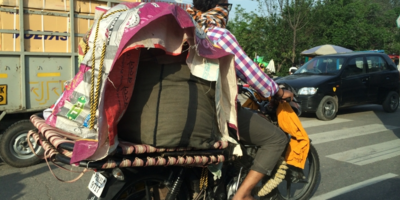
Meet Dr Soumyadeep Bhaumik, Research Fellow - Injury Division
Soumyadeep Bhaumik is a Research Fellow at the George Institute for Global Health. He has studied medicine at Bankura Sammilani Medical College, India and international public health at the Liverpool School of Tropical Medicine, United Kingdom.
Can you tell us a bit about your professional background and why you decided to become a public health researcher?
I trained as a medical doctor from Bankura Sammilani Medical College, a rural medical college in West Bengal. I loved clinical work and interactions with patients but also had an interest in medical research. I conducted two short-term ICMR projects during my training and started working as an emergency medicine physician in a world class private hospital in Kolkata.
It was in this phase that I slowly started understanding how the clinical outcomes were intrinsically related to the way our health systems were set up.
In my medical school we did not even have CT scan facility 24x7, but at the hospital I had an MRI report being delivered within minutes to the emergency department through teleradiology. It is at this phase, that I slowly started veering towards public health.
I grabbed an opportunity to work with the South Asian Cochrane Centre in a research position. After working a couple of years in evidence based medicine, I did a master's in international public health in Liverpool School of Tropical Medicine(LSTM), UK. After returning to India, I worked for LSTM in Bihar. Before joining The George Institute for Global Health, India I worked in Public Health Foundation of India.
What is your current focus area of research at The George Institute for Global Health, India?
I work in the Injury Division and we are working on several tracks in the domain of injury research- clinical epidemiology, formative research, intervention research, evidence syntheses and health systems and policy research. The International Orthopaedic Multicentre Study in Fracture Care (INORMUS) which is a large hospital based cohort study aiming to understand major complications for patients with fracture and dislocation is a big part of the work I am involved in.
I also manage the Rehabilitation Prescription Allowing Improved Injury Recovery (RePAIR) Project an intervention study on home-based rehabilitation for trauma patients. I am also involved with qualitative research to understand the impact of recurrent floods in the Char Community in Assam and to understand issues pertaining to road traffic injuries in adolescents in India.
We have quite a significant portfolio in evidence syntheses where we are doing rapid reviews on falls, unintentional injuries among the elderly for WHO, qualitative evidence syntheses on facilitators and barriers for use of child restraints in cars. I am also doing some evidence syntheses and quality appraisal for clinical practice guideline on snakebite. This apart, I am also providing technical support to our drowning prevention project BHASA in Bangladesh.
What inspires you in the work you do and why?
I moved from clinical medicine to public health to better understand health systems and develop better systems for my country. That remains the primary motive and using research as a tool for this purpose keeps me running. On a day- to-day basis, the wonderful colleagues and supervisors in the Injury division, keeps me going.
Do you have any other professional interests apart from research?
I am a firm believer in public engagement and advocacy built around science in general and health in particular.
I hence blog, tweet and talk about public health a lot. We need societies to be involved in science and technology to bring meaningful change for the better.
I am also interested in medical editing and an Associate Editor, Evidence Syntheses at BMJ Global Health.
What do you like most about working at The George Institute?
Apart from the wonderful colleagues, I like the mission of The George Institute for Global Health to improve health of millions of people worldwide. I believe by providing the best evidence to guide critical health decisions, we can really improve lives of people. The work environment is also very enabling and supportive in the organization and this helps me grow professionally.



